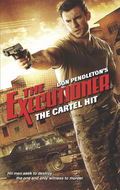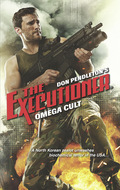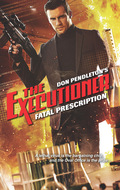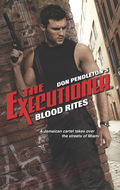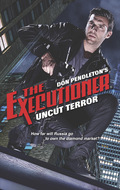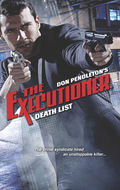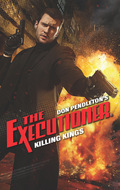Книгу нельзя скачать файлом, но можно читать в нашем приложении или онлайн на сайте.
Читать книгу: «Omega Cult»
SPLINTER SECT
North Korean terrorists unleash a devastating sarin-gas attack on Los Angeles: payback for US opposition to their homeland’s nuclear expansion. With casualties mounting and fear of future strikes on the rise, Mack Bolan follows the trail of violence to the zealous billionaire funding the deadly campaign. Taking him out—and saving thousands from an arsenal of suitcase bombs and biochemical weapons—will mean penetrating North Korea’s treacherous border. But the Executioner’s bloody pilgrimage won’t end until he sends this scum straight into the afterlife.
The house and grounds went dark, but Bolan knew exactly where his first three targets were.
Sweeping the muzzle of his scattergun across the patio, he triggered three quick twelve-gauge rounds, each blast spewing nine pellets of double-O buckshot, each pellet equivalent to a .33-caliber bullet.
His targets never knew what hit them, blown away and tumbling on the flagstone patio, awash in blood. Somewhere inside the house, a male voice shouted, challenging the sudden dark.
Light from the burning, melting generator shed showed Bolan where he had to go—rushing across the lawn through roiling smoke, past burning patches where napalm has set the grass on fire—and Chan stayed with him, matching stride for stride.
Whatever hell awaited them, they would be meeting it head-on.
Omega Cult
Don Pendleton

For Staff Sergeant Robert James Miller Nari District, Afghanistan; January 25, 2008

Nothing less than a war could have fashioned the destiny of the man called Mack Bolan. Bolan earned the Executioner title in the jungle hell of Vietnam.
But this soldier also wore another name—Sergeant Mercy. He was so tagged because of the compassion he showed to wounded comrades-in-arms and Vietnamese civilians.
Mack Bolan’s second tour of duty ended prematurely when he was given emergency leave to return home and bury his family, victims of the Mob. Then he declared a one-man war against the Mafia.
He confronted the Families head-on from coast to coast, and soon a hope of victory began to appear. But Bolan had broken society’s every rule. That same society started gunning for this elusive warrior—to no avail.
So Bolan was offered amnesty to work within the system against terrorism. This time, as an employee of Uncle Sam, Bolan became Colonel John Phoenix. With a command center at Stony Man Farm in Virginia, he and his new allies—Able Team and Phoenix Force—waged relentless war on a new adversary: the KGB.
But when his one true love, April Rose, died at the hands of the Soviet terror machine, Bolan severed all ties with Establishment authority.
Now, after a lengthy lone-wolf struggle and much soul-searching, the Executioner has agreed to enter an “arm’s-length” alliance with his government once more, reserving the right to pursue personal missions in his Everlasting War.
Contents
Cover
Back Cover Text
Introduction
Title Page
Dedication
Legend
Prologue
Chapter 1
Chapter 2
Chapter 3
Chapter 4
Chapter 5
Chapter 6
Chapter 7
Chapter 8
Chapter 9
Chapter 10
Chapter 11
Chapter 12
Chapter 13
Chapter 14
Chapter 15
Epilogue
Extract
Copyright

Prologue
Los Angeles, California
Jang Il-woo, age twenty-three, boarded the Metro Express Line 442 at the Hawthorne/Lennox Station, at seven-thirty on Tuesday morning, bound for downtown LA. No one aboard the train noticed the slender Korean expatriate dressed in a cheap business suit, horn-rimmed glasses and black wingtips. Just another of the city’s countless worker drones, bound for an office job downtown and none too happy that he still had four full days to work that week.
As the train filled, passing through twenty-seven stations on its way to the Staples Center multi-purpose sports arena and the looming skyscrapers beyond, Jang kept eye contact with his fellow passengers to a minimum, staring out the window beside him, counting down the final minutes of his life. The briefcase sat between his feet, its deadly secret hidden from the others traveling their last few miles toward doom.
Jang had no fear of death. He had resolved it through his prayers and other actions of devotion to the cause that ruled his life and had determined when that life on Earth should end. It comforted him to imagine what would follow his demise, the great leap forward for his homeland and the world at large.
A resident of the United States for nearly two years now, complete with green card, Jang had never actually planned to settle in the West. His course had been set more than a year before he applied for his US Permanent Resident Card and was accepted on the basis of his fabricated academic record, indicating he held a master’s degree in business management and mass communication from Seoul’s Chung-Ang University. His application also claimed a standing job offer from Choeusu Productions in Los Angeles, a public relations firm operating from a phone bank and post-office box in West Hollywood and had no living officers or formal personnel.
Within the anthill of Los Angeles, Jang was invisible.
That was about to change.
Inside his shiny briefcase Jang carried a twelve-pound aerosol dispenser filled with sarin: a colorless, odorless, liquid nerve agent listed as a weapon of mass destruction under international law. Stockpiling sarin had been banned under the Chemical Weapons Convention, presently signed by all but five nations on Earth.
No matter. Any clever chemist could produce sarin, given the proper equipment and adequate supply of base materials.
Jang did not understand the chemistry, nor did he care to. All he had to do this Tuesday morning was to wait for a full car and loose the gas to do its lethal work. As he reached down to free the latches on his case, his mind echoed the last words spoken by his master, barely half an hour earlier: “Breathe deep, sleep well and wake in Paradise.”
* * *
CITY HALL, at 454 feet, was LA’s tallest building from 1928 to 1964, when a revised building code permitted the erection of taller downtown structures. Even after a four-year seismic retrofit between 1998 and 2001, it remained the tallest, base-isolated structure on Earth, employing one of the most reliable architectural methods devised to protect tenants from earthquakes.
Kim Jun-ha, age twenty-six, knew nothing of that history when he stepped onto city hall’s observation deck at 9:05 a.m. Taken for an Asian tourist by the citizens who saw him, branded by his backpack and the Nikon D5300 DSLR camera around his neck, he passed unnoticed on his ride up in the elevator, totally ignored by other Tuesday-morning sightseers as he began to circumnavigate the deck, peering across the hazy vista of a city doomed to die.
In his backpack Kim carried an aerosol dispersion device identical to one that would be opened by Jang Il-woo aboard the Metro Express. Unlike Jang, he also carried a Beretta 8000 semiautomatic pistol. It was tucked under his belt, beneath the plain gray hoodie that he wore. The pistol held sixteen rounds of 9 mm Parabellum ammunition. He carried no spare magazine; Kim knew he would not be needing one.
Step one of his assigned duty was to remove the aerosol device from his backpack, hold his breath while he opened the nozzle, then fling it as far as he could manage toward the teeming street below. The observation deck at city hall had no screens to dissuade him or to prevent determined suicides from jumping, just a chest-high railing to avoid potential litigation from an accidental fall.
Simple.
One of the tourists on the deck—a thin, blonde woman—saw him set his backpack down, extract the sarin canister and twist its only knob before letting it fly toward North Spring Street—a hurtling speck that left a trail of lethal gas and would shatter when it struck the pavement after seconds in free fall.
The blonde poked her male companion and shouted at Kim, “Hey! You can’t do that!”
“Of course I can.” Kim answered, shooting her in the face with his Beretta. Her friend fell next, as Kim Jun-ha proceeded on a circuit of the observation deck, blasting away at anyone he saw.
Along the way, he counted shots, remembering what he’d been told that morning before setting out: “Be sure to save one bullet for yourself.”
* * *
THE WILSHIRE FEDERAL BUILDING in Sawtelle, a westside unincorporated area surrounded by the city of Los Angeles, stood 259 feet high and housed the city’s FBI field office, Passport Agency, General Services Administration as well as other critical facilities.
Given the building’s purpose and the modern state of terrorism, foreign and domestic, its security precautions were rigorous. Armed guards in uniform command the lobby, funneling all arrivals through metal detectors and explosive “sniffers,” while their bags traveled along conveyor belts through finely tuned X-ray machines. In theory, no terrorist or lunatic opponent of the US government could clear those hurdles and proceed upstairs into the offices themselves.
No problem.
Son Na-eun, age twenty-one, did not intend to pass through Wilshire Federal’s security. For him, it was enough to simply breach the lobby, occupying space with all those workers, guards and their machines, to carry out the work he’d been assigned.
Like Jang Il-woo and Kim Jun-ha, Son carried an aerosol sarin dispenser—this one in a book bag—when he entered Wilshire Federal’s lobby at 9:20 a.m. on Tuesday. While a dozen other citizens lined up in front of him, Son set his bag on the lobby’s marble floor, opened its zipper and was reaching in to twist the canister’s dispersal knob when he was spotted by one of the guards in uniform.
“Heads up!” the guard cried out to his companions, reaching for his Glock sidearm. “Book bag!” And then, to Son, “Stand up and let me see your hands!”
Son raised his smiling face and told the guard, “Too late,” already opening the aerosol dispenser’s nozzle, breathing deeply as the gas dispersed.
He was the lucky one. A .40-caliber bullet drilled his forehead, slamming Son backward into oblivion before he could experience the first symptoms of poisoning, preventing proper operation of an enzyme that acted as the human body’s “off switch” for various glands and muscles. Without that cutoff, said glands and muscles were constantly stimulated, inducing swift unconsciousness, convulsions, paralysis and respiratory failure leading to death.
The guard who reached Son seconds later, gun in hand, was not so fortunate, nor were the others in the Wilshire Federal lobby, vomiting and gasping as they died.

1
Arlington, Virginia
Mack Bolan, aka the Executioner, had been enjoying a rare few days of R and R, hiking in the Rocky Mountains, when a call came from the man he considered his closest living friend.
As he’d driven in from the Baltimore/Washington International Thurgood Marshall Airport, the soldier wondered just how long it had been since he’d had a face-to-face with Hal Brognola. Not that long, he supposed. There was always some hotspot that demanded the Executioner’s special touch. He looked forward to the lunch date with the big Fed, a veteran honcho at the Department of Justice and Director of the Sensitive Operations Group based at Stony Man Farm.
Now Bolan was seated at a booth in a slick chain restaurant, sipping a beer and glancing at his watch, noting with some concern that Brognola was twenty minutes late. Bolan had placed his order at the quarter-hour mark, checking his cell phone for a message from Brognola yet again and finding none.
Tied up, no problem, Bolan thought. At Justice, those things happened on a daily basis, covering a range of crimes from white-collar finagling to espionage, domestic and foreign terrorism, cyber theft, high-power drug deals and the patchwork quilt of global organized crime. A sudden call from anywhere on Earth could dump the day’s plans in a heartbeat, sending special agents and their bosses off on hazardous exploits they’d never planned.
So he would eat. If Brognola didn’t put in an appearance by the time he cleared his plate, he would leave and reach out to Stony Man to learn if anything was wrong, whether he should plan another rendezvous or just forget it.
It was his call, a failsafe built into the system when the Phoenix Program and the hardsite in Virginia’s Blue Ridge Mountains were first established. Bolan had been “dead” then, publicly incinerated with his old war wagon in Manhattan’s Central Park, all trace of him erased from law-enforcement records if not from old newspaper files.
For all public intents and purposes the Executioner was now a part of history. On the record, he’d gone down fighting—but in truth, he’d never stopped. The list of criminals and terrorists who’d learned that to their sorrow was a long one, growing day by day.
While Bolan waited for his meal, he watched the flat-screen television mounted in a nearby corner of the restaurant. It was tuned in to CNN, the sound muted in favor of closed captioning so diners wouldn’t be distracted from their small talk if they chose to shut the news out of their minds. This afternoon, as for the past two days, the lead story on every channel with a news feed focused on Tuesday’s LA suicide attacks. By now the butcher’s bill had topped two hundred dead, including three “suspected” terrorists. Nearly half again that number had been confined to Southland hospitals, some of them not expected to survive.
Sarin was like that, ranked by toxicologists as twenty-six times more deadly than cyanide. Certain antidotes could save its victims, typically atropine and pralidoxime, but they had to be administered without delay. The greater any given victim’s personal exposure, the more rapidly they lapsed into the final, agonizing moments of their lives. That last stage was captured in mnemonics: the “Killer Bs” of bronchorrhea and bronchospasm, coupled with salivation, lacrimation, urination, defecation, gastrointestinal distress and emesis.
In short, it was one hell of a way to check out.
The three dead men who’d gassed LA had been young Korean immigrants. According to the media, all three had entered the United States through legal channels and were known to hold steady jobs. Beyond that, any information known to the LAPD, FBI or Homeland Security was strictly under wraps. And that naturally fueled rabid speculation on talk radio, websites dedicated to conspiracies and the kooky netherworld of the Dark Net where certifiable fanatics and false prophets rubbed shoulders with self-styled psychics, gunrunners and child pornographers.
Something for everyone, from sea to shining sea.
The Asian angle fueled no end of fervid speculation as to motive and the ultimate ID of whoever had devised the lethal plot. Coordination—a conspiracy by definition—couldn’t be denied. But how far did it reach? How high? Where were the roots of the attack? So far, China, Japan and both Koreas had been implicated by those claiming to be “in the know,” while others aimed accusing fingers at the US government in Washington. It was a “false flag” plot, they said, conceived by Democrats, Republicans, conservatives or liberals, to bring on Armageddon and a state of martial law ending with tyranny.
The waitress came with Bolan’s steaming plate and he dug in after he checked his watch once more. From long experience, he knew it would take him half an hour, give or take, to finish his lunch. If Brognola had not appeared by then...
A shadow fell across his table.
Bolan glanced up, found Brognola standing over him, frowning. “Sorry I couldn’t call,” he said. “This thing is getting out of hand.”
The big Fed sat across from Bolan at the small table for two. The waitress spotted him and circled back in the hope of doubling her tip. Brognola eyeballed Bolan’s plate and said, “I shouldn’t, but I’ll have the same. Light beer for me.”
When she was gone, Brognola took off his fedora, set it on a corner of the table to his left, and said, “Three guesses why we’re here.”
“Los Angeles,” Bolan replied.
“Got it in one. Have you been following what’s going on?”
“Only what’s on the news.”
“Tip of the iceberg,” Brognola declared. “We’ve got more than the media, as usual. It’s not as wacky as the crap you’ll find if you start Googling, but it’s bad enough.”
“Tell me.”
“First up...” The big Fed hesitated as his beer arrived. He sipped it and then forged ahead. “First up, all three of the known perps were South Korean nationals. They all applied for green cards through the US Embassy in Seoul, over a span of thirteen months, and got approval from the INS as LPRs—lawful permanent residents. All settled in LA and nailed down jobs with different companies. First glance, none seemed to be acquainted with the others.”
“But at second glance?” Bolan inquired.
“As you’d imagine, we’ve put all their lives under a microscope, cooperating with South Korea’s National Intelligence Service and their National Police Agency. None of the doers resided in Seoul for more than a few weeks before they applied for their visas. All three came from different provinces. No shared addresses or employment in the capital. We did find something, though.”
“Which is?”
“Are you familiar with a cult called Omega Hoejung?” Brognola asked.
“It doesn’t ring a bell.”
“In English, that translates to the Omega Congregation, as in final. It was founded nineteen years ago by Shin Bon-jae, a self-made billionaire from Seoul who’s got his fingers in a couple thousand different pies from manufacturing and shipping on to journalism. In the States, he runs the Washington Inquirer, giving any major piece of news a right-wing twist. He sells himself as strictly anticommunist, in line with Rhee Syng-man from the Korean War, through Park Chung-hee, on down to Park Geun-hye. He hates the North Korean crowd and likes to talk about reunifying the Koreas under what he calls ‘benevolent autocracy.’ Dictatorship, in other words.”
“What’s the religious angle?” Bolan asked.
“That’s been the major snag for people trying to decide what Shin’s really about. He’s both a guru and a CEO, which seems to be a contradiction, but he’s made it work for him so far. Worldwide, he has an estimated quarter-million followers, most of them living in East Asia. But they have a good-size group in Russia—five, six thousand by most estimates—and you can find them all around the States. Maybe another six or seven thousand known to follow Shin’s lead work in upper levels of his companies and follow all the Congregation’s rituals. It’s tax exempt on this side of the water, naturally, which is helpful when it comes to money laundering.”
“For what?”
“Pure speculation at this point. None of his people have been jailed for anything, as far as I can tell, but ATF reports persistent rumors of arms smuggling. Interpol and ICE suspect Shin’s got a hand in human trafficking, moving his people here and there around the world without the legal paperwork.”
“And this ties into LA how?”
“All three perps paid their dues to the Omega Congregation,” Brognola replied. When Bolan frowned, he added, “Sure, I know. Coincidence, some might suggest. And if it was a bigger sect—Buddhism or Catholicism, say—I might buy that. But from the records I’ve obtained, they only have about six hundred members of the Congregation anywhere in California. What are the odds that three of them would get their hands on sarin and coordinate attacks on the same day?”
“I’d call it slim to none,” Bolan replied.
“Which brings us here.” The big Fed paused again to thank the waitress for his meal and watched her walk away before resuming. “The Omega Congregation has its US headquarters in San Francisco, led by Lee Jay-hyun. Officially, he ranks below the founding leader as a je yeonghon. That’s ‘second soul.’ A rank applied to what you might call generals of the sect, each one in charge of operations for a given nation. Shin Bon-jae rules over all as cha ui yeonghon, the ‘primary soul.’ According to the Congregation’s doctrine, he was visited by Jesus Christ in person on his sixteenth birthday—Shin’s, not Christ’s—and was anointed as the leader of a new age leading to the Final Days.”
“So, an apocalyptic cult,” Bolan observed.
“We’ve seen how those worked out before, from Tokyo to Waco, Heaven’s Gate on to the Order of the Solar Temple. Some just kill themselves. Others, like Aum Shinrikyo in Japan, can’t wait to spread the death around.”
“How does that help a self-made billionaire?” Bolan inquired.
“Depends on what he’s thinking underneath. Is he an anticommunist in fact or something else? How would he profit from kick-starting the Apocalypse? There’s money in disasters if you play your cards right—think about the movement to rebuild a new, whiter New Orleans after Hurricane Katrina—and he might have something cooking with the North Korean crowd.”
“Where’s that come from?”
Brognola set his fork down long enough to take a CD from his pocket, sliding it across the table toward Bolan. “You’ll find details on there,” he said. “Long story short, the FBI thinks Lee Jay-hyun’s been meeting with a character named Park Hae-sung in Frisco. He’s another businessman from Seoul, ostensibly, but the Bureau and the Company suspect he’s working for the DPRK’s State Security Department.”
DPRK, Bolan knew, being the Democratic People’s Republic of Korea. Staunchly communist since 1946 and presently dominated by its roly-poly Supreme Leader, best known for sweeping human rights violations, random executions of his rivals and erratic threats of global nuclear holocaust.
“I’m guessing step one would be San Francisco?”
“That’s if you’re taking the mission,” Brognola answered.
Bolan pocketed the CD. “Sounds like it’s worth a closer look.”
“I ought to tell you this could wind up going transpacific.”
“Following the prey’s a part of hunting,” Bolan said.
Ronald Reagan Washington National Airport
BOLAN DROPPED HIS rental car in the agency’s parking lot and found his one-way ticket westward waiting at the airline’s window with three hours to spare before takeoff. He made it through security, booting up his laptop at the request of an inspector in a rumpled uniform, then hiked down to his flight’s appointed gate and found himself a corner seat, placing his carry-on in the adjacent chair so no one could sit next to him.
An earpiece for the laptop solved his problem with potential eavesdropping as Bolan slipped Brognola’s CD-ROM into the laptop’s slot and waited for its menu to appear. Four files popped up a moment later, labeled A through D.
The first broke down the history of the Omega Congregation, founded in July of 1998 by Shin Bon-jae. It started small, a curious religious sect that merged Shin’s nationalist stance on politics with the peculiar notion—previously under wraps it seemed—that he’d been visited by Jesus Christ in person, not just once but half a dozen times. The risen Lord allegedly suggested, then insisted, that Shin share his message with the masses, using the financial blessings already bestowed on him by God, to rally wide support for a reunion of the two Koreas after half a century. The chief means of achieving that reunion, Jesus said—through Shin—would be an arduous campaign of prayer.
Over time, a list of right-wing politicians had signed on to the Omega Congregation’s cause, lending their names and paying dues according to the status of their salaries. Meanwhile, the movement spread through lower levels of society, encouraged tacitly by Seoul’s prevailing leaders as a means to counteract threats and demands from its northern rival Kim Jong-il and his successor. The odd part, given its specific politics, was the Omega Congregation’s subsequent expansion through East Asia, into Europe, North America, and even to Australia, where a small but thriving chapter operated from an office suite in Melbourne.
Initially bankrolled by founder Shin via a paper company created for that purpose, the Omega Congregation was a self-supporting entity by August 1999, turning a profit—which, allegedly, it spent on missionary work—by April of 2000. Granted tax exemption as a bona fide religion in the States, it skated on the thin ice of political persuasion but survived investigations by Internal Revenue in 2002, ’04 and ’09. At that point high-priced lawyers formally protested federal harassment of the cult and won their case in 2011.
And it had been smooth sailing after that—at least, until three members of the sect released sarin nerve gas in LA
The list of dead, including terrorists, had reached 217 when Bolan checked the internet after arriving at his airport gate. At least three dozen more victims were critical, clinging to life in ICU, while close to ninety others were described by hospital authorities as being in “stable but guarded” condition.
It was not the worst terrorist attack in US history, but coming out of nowhere as it had, without a hint of any links to radical jihadists or homegrown fascist malcontents, it had taken the country and its leaders by complete surprise. No one had been alert for trouble from Korean immigrants, much less from those allied with a conservative religious sect.
File “B” relayed the history of Shin Bon-jae in greater detail than Brognola had provided over lunch. Born to humble parents in Gyeonggi Province in 1958, Shin made his way to Seoul as a teenager, worked various jobs to make ends meet, then came up with a stake from who knew where to buy a failing carpet factory. He’d turned the company around in record time and soon expanded. First to trucking, as a mode of transportation for his product, then diversifying into other types of manufacturing, founding a two-ship transport line that had expanded over time a hundredfold, and making lucrative investments with advice from certain wealthy friends in industry and politics. His first newspaper, Seoul’s Truth in Action, had been launched in 1970, spreading globally over the next twelve years as Shin founded affiliated papers on six continents, in nineteen languages.
His great conversion to religion, never indicated in his public statements previously, came a week after Shin’s fortieth birthday. On July 4, 1998, he was prepared to share the word. He put his money where his mouth was at the start, and was rewarded over time by one more profit-making branch of his empire. How many other bootstrap billionaires were ranked among the richest men on Earth and heralded by followers as an enlightened mouthpiece of Almighty God?
Thus far, there’d been no hint of Shin or his hand-picked lieutenants preaching violence, although the Congregation’s doctrine did maintain that the reunion of fractured Korea might require apocalyptic sacrifice. In Seoul, such rhetoric was not unusual: leaders of South Korea had been talking war since 1948 and—unknown to most Americans—illegal border crossings by the troops of first president Rhee Syng-man had motivated North Korea’s Kim Il-sung to order an invasion of the South in 1950, starting the Korean War and ultimately drawing Red China into the fight. Outside Korea, Congregation speakers kept it on the down-low, pressing would-be members to donate whatever they or their extended families could spare to help the cause.
File “C” picked up with Lee Jay-hyun, Shin’s front man in America. At thirty-two, he’d climbed the Congregation’s ladder rapidly, from raw recruit to office aide in Seoul, promoted once again after he’d saved Shin’s life from a demented gunman in October 2002 outside the cult’s Heavenly Palace in central Seoul’s Jongno-gu district. Elevated to the august rank of second soul, Lee soon turned up in San Francisco with a work visa identifying him as a religious missionary. One year later that had been converted to a green card naming him as a permanent resident of the US.
Lee’s church and headquarters in San Francisco was located in Ashbury Heights, on a hill south of the once-notorious Haight-Ashbury neighborhood. Bolan had pegged it as one of his first stops when he reached the coast.
File “D” was sparse but interesting, focused on Park Hae-sung, reputed businessman from Seoul, suspected—as Brognola had explained—of being an illegal agent of North Korea’s State Security Department. Since North Korea had no consulates in the United States, the FBI and CIA had no hard proof of any links between Park and the SSD, but agents of the National Security Agency claimed he was in contact with Pyongyang via covert telephones and radio broadcasts, pending decryption that would give an indication of their contents.
Evidence that would have bolstered an indictment: zero.
It was one more thing for Bolan to determine when he got to San Francisco, and he hoped he wouldn’t leave his heart—or body—there when he was done.
Бесплатный фрагмент закончился.
Начислим
+11
Покупайте книги и получайте бонусы в Литрес, Читай-городе и Буквоеде.
Участвовать в бонусной программе

